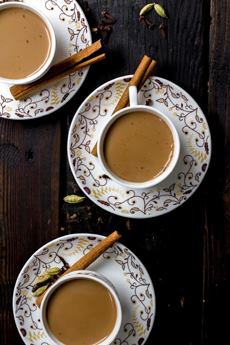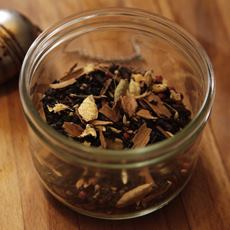Make Spiced Tea: Recipes For Easy Spiced Tea & Masala Chai
|
|
Many tea lovers buy spiced tea as a fall and holiday favorite; gift tins are popular holiday gifts.
For home, perhaps the most popular spiced tea is the first major commercial brand, Constant Comment. A longtime favorite of ours (and the most popular specialty tea in the U.S.), the original black spiced tea bags are now available in decaffeinated black tea and green tea. It’s also available as loose tea. But if you’re home and hankering for a cup of spiced tea, with none in the house, the solution is simple: Just make your own with the tea and spices you already have in the kitchen. In addition to black tea, you can make green spice tea or white spice tea, or rooibos (caffeine-free red tea) spice tea, exactly as Ruth Bigelow did when she created Constant Comment Tea in 1946. A bit of a grammatical note on spice vs. spiced: Ingredients For 2 Cups You can keep playing with the spice mix until you have your perfect recipe (see more ingredients in the section below). You can fill jars with your signature tea blend and give them as gifts to tea-loving friends. For friends who don’t use loose tea, add these unfilled drawstring tea bags. |
|
|
Preparation 1. COMBINE the water, cinnamon, and cloves in a medium pan. Bring to a boil; reduce heat. Cover and simmer for 5 minutes. Remove from heat. 2. ADD the tea bags; steep for 5 minutes. Remove the tea bags and spices. 3. SERVE the tea hot or iced with a lemon wedge and choice of sweeteners, although the spice flavors are so exciting that no sweetener is necessary. You can also infuse the tea with: *Here are 10 herb choices from Garden.org. 1. With a spice ball. We prefer the new twist-and-lock spice ball style. The closure is less likely to loose with continued use. 2. Loose. If you don’t have a spice ball, just infuse all of the ingredients in a pitcher or a large measuring cup, ideally one with a pouring spout. Then pour the tea through a strainer, into the cup. There are many devices for steeping loose tea, from simple infusers to more complex devices; for example, travel mugs and electric teapots with built-in infusers. IngenuiTEA is our favorite device. Tea steeps in the unit, then easily dispenses into the cup. |
||
|
RECIPE #2: MASALA CHAI Masala chai is Hindi for spiced milk tea (masala = spice, chai = tea). It’s a strong black Indian tea infused with spices—commonly cardamom, cinnamon, ginger, peppercorn, clove, and nutmeg (chocolate or licorice are sometimes included)—with milk and sugar. Traditionally, the milk and tea water are boiled together, then infused. This ensures that both liquids are hot. In the era of the microwave, you can infuse the tea in boiled water and then add heated milk. While masala chai is traditionally made from black tea, green tea chai and rooibos chai have become popular in the West, where it is often simply called “chai.” There is no one “best” chai recipe. As with any other recipe, the best version has the seasonings you prefer, in the proportions that you want. Here’s a basic masala chai recipe that makes eight cups of tea. Take it as a starting point and adjust the ingredients and the proportions next time. If eight cups are too much for you, cut back the recipe. Or, refrigerate the remainder, store it in the fridge, and heat it as needed. You can also drink it iced. TIP: Some recipes (and store-bought blends) are pre-sweetened. If you may be serving the chai to people who prefer unsweetened tea, or use a noncaloric sweetener, omit the sweetener (the last ingredient) and provide sweeteners at the table. |
 [4] Masala chai means milk tea. In its country of origin, India, it’s black tea steeped with spices, with added milk (photo © Charles Chocolates).
|
|
|
Preparation 1. HEAT the water and milk to a boil in a saucepan. Add the remaining ingredients except for the honey and simmer, covered, for 10 to 15 minutes. 2. REMOVE from the heat and strain into another pot or bowl. Add sweetener and blend thoroughly. 3. SERVE from a conventional teapot or a pitcher; or bring pre-filled cups the table. Check out our tea Glossary: the different types of tea, with beautiful photography. |
||






